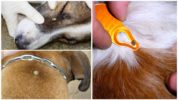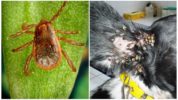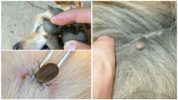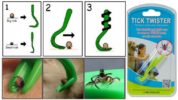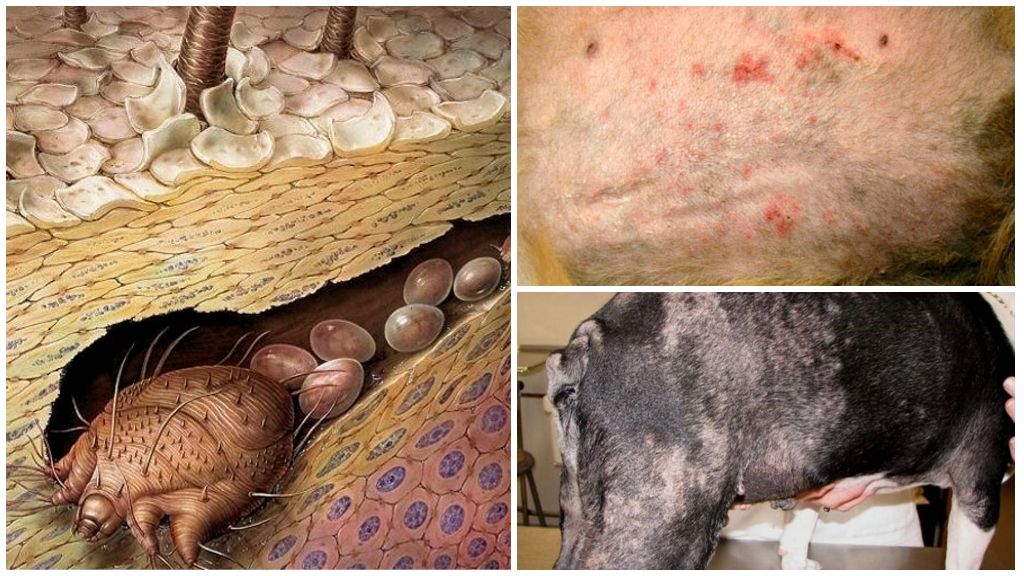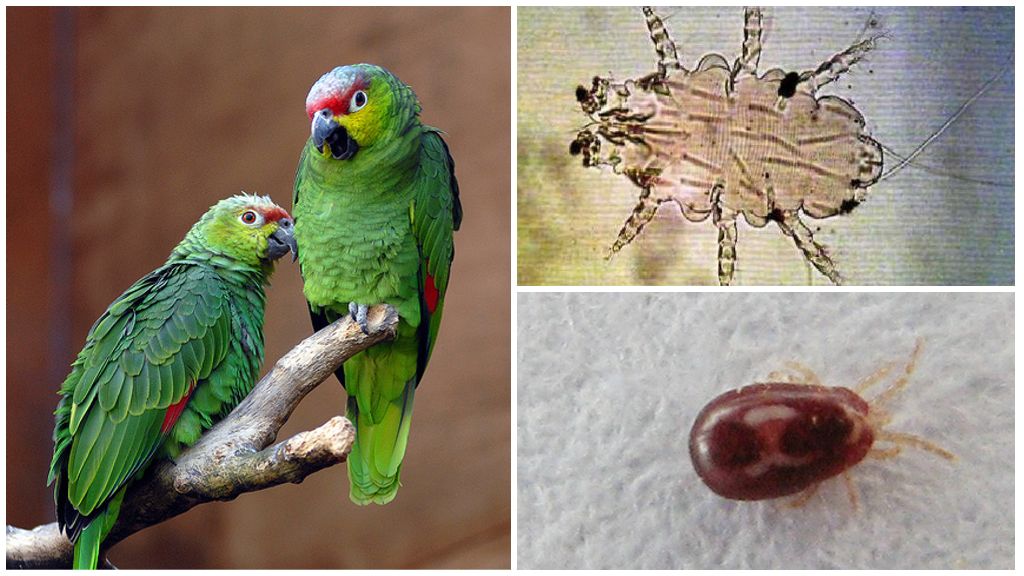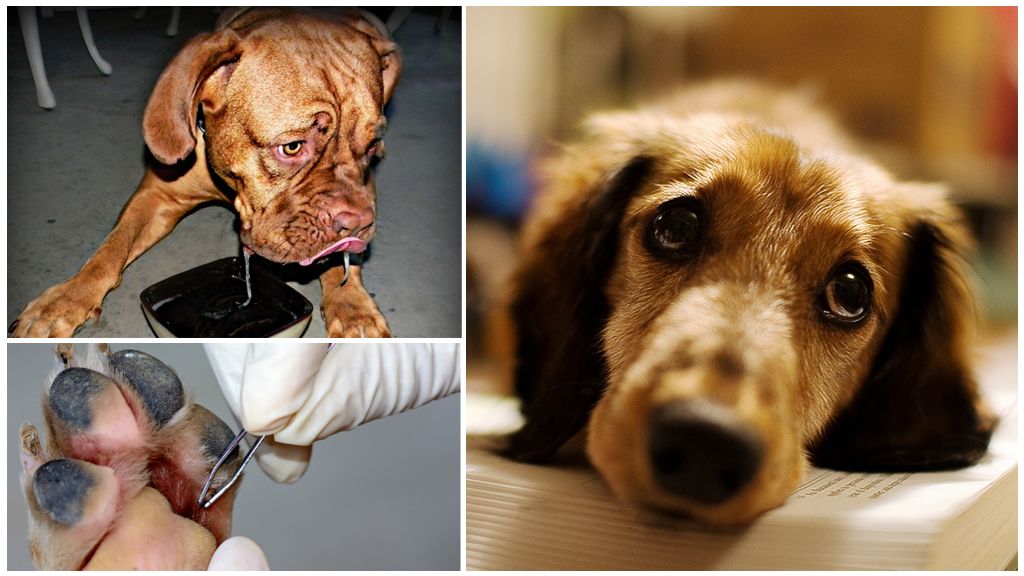- Dog ticks
- Dog tick
- Pyroplasmosis in dogs
- Dog tick
- Tick Twister tick extraction tool
- Preparations for dogs against parasites
- Pet food
Spring and summer - the time of activity of blood-sucking ectoparasites. They are able to cling to the hair of a pet, bite, infecting it with a deadly disease. Therefore, during long walks in the warm season, it is important to worry about the safety of your pet. What to do if a tick bit a dog, how to remove a bloodsucker, and in which case a veterinarian’s consultation is urgently needed, this article will tell.
Species of parasites
Many owners had to find a dried tick or tick egg in a dog (a photo of tick breeding on a dog is given below). Some begin to panic in such cases, while others do not pay much attention to this fact.
By itself mite not dangerous, and he is not able to drink all the blood. However, a bloodsucker is able to carry infectious bacteria that settle in red blood cells and damage them. Bacteria multiply quickly enough, and in the absence of appropriate treatment measures in almost 98% of cases, the disease leads to the death of the animal.
On a note!
Dog ticks in Russia, can be of different types: earplug (internal) and demodectic (intradermal) bloodsuckers, the most dangerous for a dog is ixodid tick (outer).
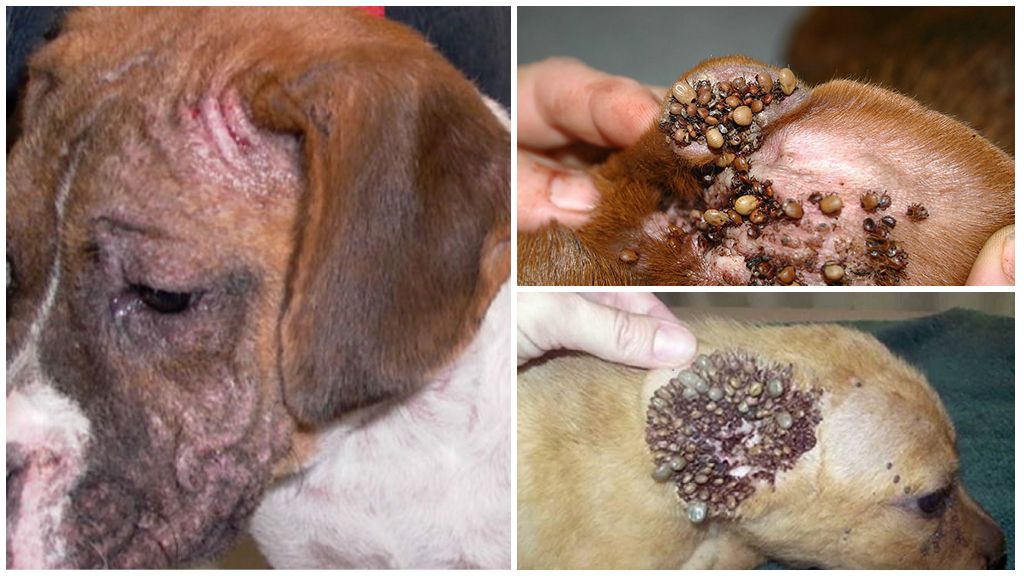
How are the symptoms of a tick bite in a dog
Symptoms of a dog bite with a tick can not be detected immediately, which is the danger of a bloodsucker attack. Most owners of four-legged friends are scared of infectious diseases with a lot of complications, but the realization that the pet is sick often comes too late.
A clinging tick on a dog begins to examine its body, looking for a place to commit a bite. Depending on the state, the parasite can have a different look:
- a small white tick in a dog - a hungry bloodsucker;
- a large burgundy or orange tick is a parasite that has already drunk blood.
On a note!
In a state of hunger, a bloodsucker is no more than a match head, so it is almost impossible to notice it in the pet’s thick coat.
Typically, the parasite prefers areas with more delicate skin: it can be seen in the eye area and near the ears, in the groin or armpits, as well as on the inside of the thighs. Before a tick appears under the skin of a dog, it injects a special substance with analgesic properties into the skin, as a result of which the pet does not feel a bite. After that, the bloodsucker is screwed into a tiny hole, continuing to dig deeper and deeper into the victim's tissue (the photo of the tick in the dog is presented below).
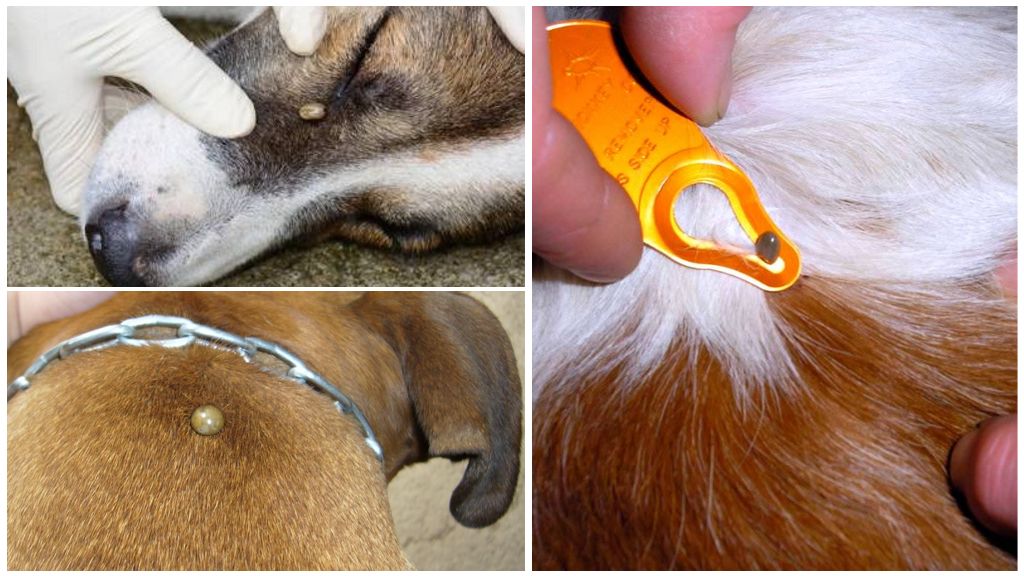
On a note!
After the meal, the tick swells on the dog, as a result of which it resembles a large papilloma. After digesting the food, the vampire injects unnecessary waste into the victim’s body along with the microorganisms of the virus, infecting the dog with an infectious disease. How many ticks are sitting on a dog, depends on the sex of the parasite, the degree of its hunger.
You can find out that a dog was bitten by a tick by the following symptoms:
- The presence of local reactions: the bite site begins to swellblush and itch. Why the pet often licks and combes the damaged area. The site of a tick bite in a dog can also fester, caused by pyogenic microorganisms brought into an open wound.
- The presence of tick-borne paralysis, as a result of which the hind, and subsequently the front limbs are affected.
- The manifestation of neurotoxic reactions is possible, which are expressed in the form of a violation of the swallowing reflex and the vocal apparatus of the dog, as a result of which it makes hardly audible sounds.
Having found such signs of a bite by a tick of a dog, it is urgent to provide emergency help to the pet, as some bloodsuckers can become a carrier of very dangerous diseases.
What are the diseases of dogs from ticks
Depending on the causative agent of the virus, dog diseases from ticks also vary.
Babesiosis
Pyroplasmosis, babesiosis, or as people often call plasmosis in dogs, is the most dangerous disease caused by the causative agents of the Babesia canis virus. The infection is transmitted exclusively through the blood when the pest bites. The following stages of the development of the disease are distinguished:
- The chronic form is observed in animals with good immunity or in those dogs that are already sick pyroplasmosis. The incubation period of the disease can last from 4 to 15 days, depending on how many parasites are in the blood of the animal. The pet refuses food, becomes weak and exhausted. He may have a fever for several days, which subsequently normalizes. Possible manifestations of diarrhea. The pet is cured after 2-3 months after the therapy.
- Acute form. The dog becomes lethargic and weak, it loses its appetite and interest in what is happening around. As a result of an increase in body temperature in an animal, sensations of heat and fever alternate. Urine becomes dark, mucous membranes have pale integuments, breathing is frequent and heavy. If you do not provide timely treatment, then on the 3rd-7th day of the disease, a pet can die.
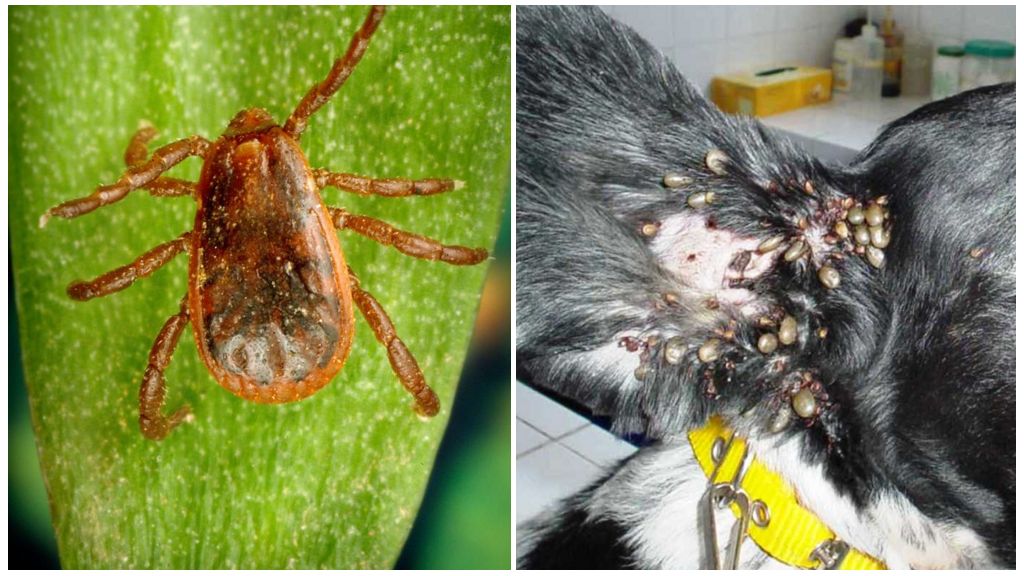
Important!
The faster the dog is shown to the veterinarian, the more favorable the prognosis for the pet to recover. Indeed, at the second stage of the development of the disease, bacteria begin to multiply actively, which increases the level of toxicity from the products of their vital activity. A bloodsucker bite is especially dangerous for small dog breeds. Therefore, if a tick bit a York or if the terrier suffered from a parasite attack, the veterinarian should be shown to the pet urgently.
Bartonellosis
Another disease that can cause a tick in a dog. The culprits of the disease are Bartonella bacteria. The behavior of a dog after a bite of a tick infected with bartonellosis changes dramatically: the animal experiences weakness in the hind limbs and sleeps most of the time. The danger of the virus lies in the fact that it can cause anemia, fever, cause meningitis and pulmonary edema. Bleeding from the nose is also possible.
On a note!
The disease has hidden symptoms, due to which the animal can be sick with it for a long time. And not every owner knows that his dog died from a tick bite.
Lyme Disease
A tick bite for a dog is also dangerous for a disease such as borreliosis or Lyme disease, caused by Borrelia bacteria. Incubation period dog borreliosis is 10-14 days, as a result of which the animal begins to refuse food, may experience fever and problems with the cardiovascular system. The pet's lymph nodes increase, lameness and stiffness in the gait becomes noticeable.
On a note!
This disease of dogs from ticks can also be transmitted from mother to fetus, often leading to the death or birth of non-viable puppies.
Hepatozoonosis
An equally dangerous infection that a dog can catch is not only after being bitten by a tick infected with Hepatozoon bacteria, but also if it is accidentally swallowed. The disease manifests itself in the form of fever and lacrimation, pain in the joints and muscles, general weakness of the animal. After infection with hepatozoonosis, more than one year can pass before the manifestation of obvious signs of the disease.
What to do if a tick bit a dog

The consequences of a tick bite in a dog described above can be avoided if the pet is given first aid in a timely manner. This is especially important if the tick bit the puppy.
- Having discovered that a tick has stuck to the dog, it is necessary to remove it from the body of the pet as soon as possible. After all, the longer the parasite will feed on the blood of the animal, the higher the risk of contracting the disease.
- Bite Handling - the next stage of assistance. It is necessary to treat a tick bite in a dog with any antiseptic: the wound can be smeared with iodine, hydrogen peroxide or alcohol. The tick extracted from the pet’s body is placed in an airtight container and submit to the laboratory for analysis.
- After the tick has been removed from the dog, it is necessary to closely monitor its behavior. After all, the disease can manifest itself after a few days after a bite. Usually the owner rarely associates poor appetite in the winter with the fact that in the spring the dog suffered from a tick bite. Therefore, it is necessary to remember this incident and, if the above symptoms occur, urgently show the pet to the doctor.
Important!
If the dog was bitten by ticks in different places, then it is urgent to contact a veterinary clinic. A large amount of toxins can lead to the death of the animal.
How to pull out a tick
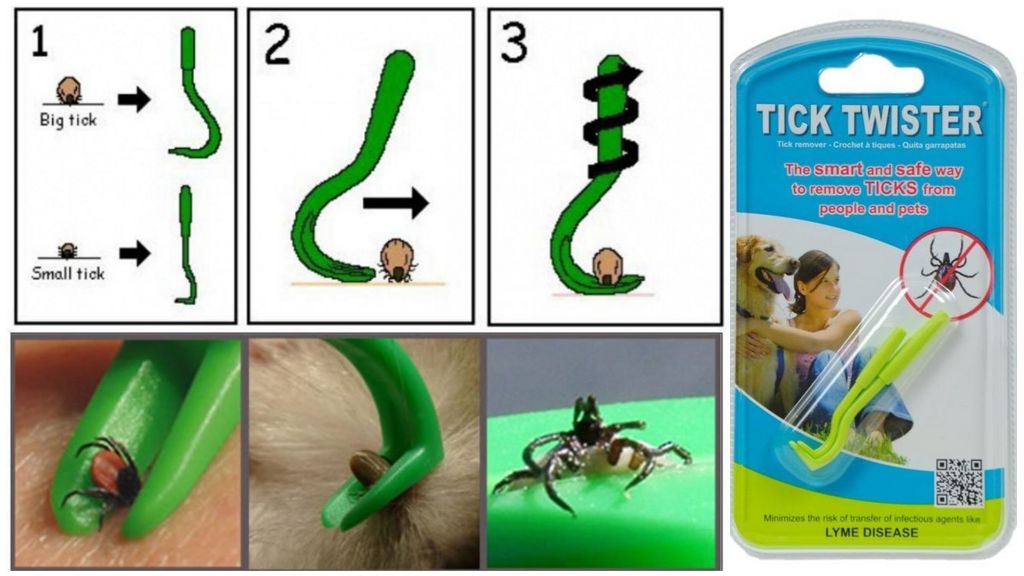
In order to avoid infecting a person with a dangerous disease, the procedure for extracting the parasite from the body of the animal should be carried out with surgical gloves. Remove tick with tweezers or a thread, grabbing the body of the pest as close to the surface of the dog skin as possible. The individual is removed by slow smooth movements, rocking its body or turning counterclockwise. Hold the skin of the pet with the other hand.
Well, if there is an opportunity to purchase in a pharmacy special fixture to extract bloodsuckers called Tick Twister. This kind of grip can be of two variations: for bloodsuckers in a normal state and enlarged after a meal.
Important!
No need to try to take out the parasite with the help of sunflower oil, trying to shut off oxygen to it. In response to such actions, the bloodsucker will actively inject saliva into the body of his victim. It is also not worthwhile to use kerosene or another mixture of a similar composition to neutralize the tick. Tearing or crushing the parasite is also unacceptable. If this is not observed, there is a high probability of infection with an infection, the parasite could be a carrier of it. After all, along with saliva, pathogenic microorganisms penetrate the blood of a pet.
How and how to treat a dog after a tick bite

Having discovered a trace of a tick bite in a dog or the presence of symptoms of a disease, a pet is prescribed treatment in a veterinarian. Usually recommend drugs that have antiparasitic properties:
- Piro-Stop is an antiprotozoal drug based on imidocarb dipropionate for subcutaneous and intramuscular injections. Effective for the treatment of anaplasmosis, babesiosis, ehrlichiosis and other blood-parasitic diseases. The solution is used at the rate of 0.25-0.5 ml per 10 kg of animal weight once.
- Veriben is a drug for treating dogs with protozoal diseases such as pyroplasmosis, babesiosis, trypanosomiasis. The active substance of the powdered agent is diminazine (44.5%). To prepare the solution, a bag of powder (2.36 g) is combined with distilled water or saline (25 ml). The resulting composition is used for intramuscular injection (1 ml per 10 kg of pet weight).
- Azidine is a medication for the treatment of protozoa, which is based on phenazone and diminazen acetate. The contents of the vial are dissolved in a double volume of water, obtaining a 3.5% solution, which is administered at the rate of 0.1 ml per 2 kg of body weight, a second injection is administered every other day.
- Pirosan is another remedy of a similar composition based on diminazenaceturate and phenazone. 2.36 g of powder is diluted in 25 ml of water for injection, or 0.5 g of powder in 5.5 ml of water for injection at a dose of 1 ml per 10 kg of animal.
- Imidosan is a drug for the treatment of parasitic blood diseases, such as babesiosis, anaplasmosis, nuttaliosis. The active component in it is imidocarb dipropionate. The solution is used exclusively for subcutaneous injection, which is injected into the neck at a dose of 0.25-0.5 ml per 10 kg of animal weight.
- For normal kidney activity, sodium bicarbonate is injected intravenously, which prevents the formation of hemoglobin in the urine.
- Vitamin preparations for dogs (vitamin B12) are essential for maintaining the body.
- Physiological salt solutions will help remove intoxication and restore the body's water balance. It is necessary to give the dog a drink of a sip every 10-15 minutes.
- Treatment in dogs with folk remedies in the acute period is not recommended, since the consequences after unauthorized treatment are very deplorable.
It is equally important after infection to properly feed the dog. If the pet is very weak and refuses its favorite foods, feeding forcefully (from a spoon or syringe) will put a big load on the body. Usually in such situations a nutritious dropper is placed for the dog after a tick bite.

If the dog, although a little, but still shows interest in food, then he should be fed with minimal portions several times a day. It is better if the diet of a sick animal will be the following dishes:
- buckwheat and rice porridge;
- boiled vegetables;
- beef or turkey mashed potatoes;
- corn or olive oil;
- dry food swollen in boiled water;
- canned food in a warm form, mixed with water.
On a note!
Any food must be given to the animal in a warm form. Also, the pet must have clean water available. The load should also be limited: short walks at a leisurely pace, refusal from training, competitions and various exhibitions.
The recovery period, depending on the severity of the disease, can last up to 2 months. After that, the pet must be shown to a specialist again and a second blood test taken.
How to save a dog from a tick bite
One hundred percent protection against ticks does not exist today, but there are a lot of effective meansThanks to which you can save the pet from parasite attacks. It can be collars or drops at the withers, tablets, spraysthat are effective not only against ticks, but also various annoying insects. It is enough to use them in accordance with the instructions and parasites will not be sucked.
There is also a vaccination for a dog after a tick bite. It is enough to inject an animal with a vaccine such as Nobivak Piro or Pirodog, and he will develop immunity to parasites. However to instill an animal - does not mean at all that it is completely protected from bloodsuckers: the vaccine only alleviates the symptoms and treatment at home of the disease, which reduces the number of deaths. To achieve maximum protection, it is advisable to combine vaccination with tick control products.

